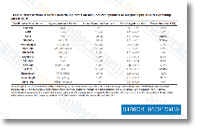RNAseq, short reads counting approach For expression analyses, Illumina reads have been mapped about the 80714 rose clusters using the following BLAST para meters. A greatest of 2 mismatches was authorized and only alignments of 24 or far more nucleotide had been kept. Alignments were filtered holding only the perfect score. Yet, selleck chemicals due to dataset complexity some quick reads had been mapped and impacted to greater than one particular cluster. Ultimately, matches have been counted and RPKM computed per cluster and per libraries. Heatmap was created implementing RPKM information making use of the MeV examination instrument. qPCR analysis One microgram complete RNA was used in a reverse transcription assay and qPCR as previ ously described. Expression levels have been normalized with Rc alpha TUBULIN, RcTCTP, RcACTIN and RcEF1 alpha reference genes. At least two independent biological replicates had been used for each experiment and two qPCR technical replicates have been per formed for every biological replicate, with similar final results.
Primer sequences can be found as Supplemental file five, Table S3. The correlation concerning the RNAseq effects and qPCR information was assessed by calculating the Pearsons hop over to here item moment correlation coefficient. Background Genomes are underneath frequent threat of damage from exogenous variables and endogenous processes that result in DNA lesions. Correspondingly, cells have evolved elaborate DNA harm response mechanisms to keep genome integrity and stability. DDR integrates the DNA restore system together with the cell cycle regulation, chroma tin dynamics and programmed cell death, requiring delicate coordination of hundreds of genes. Due to the fact DNA harm underlies the onset of cancer, aging, immune deficiencies, together with other degenerative disorders, urgent desires of public wellness have created DDR a major target of research for many years. DDR is extremely conserved for the duration of evolution.
Essential components from the DDR network, such as ATM/ATR pathway, non homologous ends joining and ho mologous recombination restore, share homologues among essentially all the eukaryotes. Thus, scientific studies within the DDR in lower eukaryotes can offer beneficial infor mation to elucidate the mechanism in higher organisms. Mainly because of their experimental amenabilities, budding yeast and fission  yeast are becoming fantastic designs for DDR research. Fission yeast separated from budding yeast about 1,000 million many years ago throughout evolution. S. pombe includes about 150 metazoan homologous genes which cant be observed in S. cerevisiae, and a comparable number is viewed when this comparison is produced for S. cerevisiae. This emphasizes the benefit of applying both yeasts for essential studies. With the completion of the Saccharomyces Genome Deletion Undertaking in 1999, genome wide screens making use of a deletion library have become an efficient strategy to recognize novel genes involved in DDR.
yeast are becoming fantastic designs for DDR research. Fission yeast separated from budding yeast about 1,000 million many years ago throughout evolution. S. pombe includes about 150 metazoan homologous genes which cant be observed in S. cerevisiae, and a comparable number is viewed when this comparison is produced for S. cerevisiae. This emphasizes the benefit of applying both yeasts for essential studies. With the completion of the Saccharomyces Genome Deletion Undertaking in 1999, genome wide screens making use of a deletion library have become an efficient strategy to recognize novel genes involved in DDR.
Hdac Assay
Histone deacetylase 7 is an enzyme that in humans is encoded by the HDAC7 gene.
